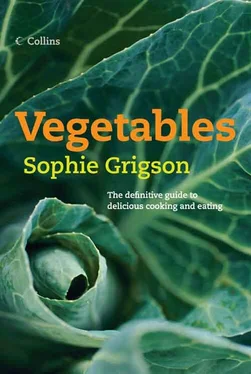The black-skinned winter radish is the one to use for more determined cooking. It needs to be peeled before cooking, then sliced thickly or cut into chunks. It can simply be simmered in boiling salted water, but is best, I find, added to meaty, chunky stews and braised gently in the savoury juices. Oriental radishes may need to be peeled (nibble a little bit first to see if the skin is palatable or not), then they can be sliced or shredded thinly for salads, both western and Asian style. They are also good stir-fried, mixed with other vegetables, or added to stews.
Sea bass with rosemary and radish stuffing
Finely chopped radishes add a gentle peppery touch to a piquant stuffing for roast sea bass.
Serves 4
1 sea bass, weighing around 1–1.5 kg (21/4-31/4lb), scaled and cleaned
olive oil
2 cloves garlic, finely chopped
2 tablespoons finely chopped rosemary salt and pepper
Stuffing
8 summer radishes, trimmed and chopped
1 shallot, chopped
1 slice Parma ham or other prosciutto crudo, chopped
1 generous tablespoon olive oil
3 tablespoons slightly stale breadcrumbs
2 teaspoons rinsed capers, roughly chopped
1 tablespoon parsley
To serve
lemon wedges
Preheat the oven to 170°C/325°F/Gas 3.
To make the stuffing, fry the radishes, shallot and ham gently in the olive oil until tender. Mix with all the remaining ingredients, plus some salt and pepper. Brush the insides of the fish with a little olive oil, season lightly and fill with the stuffing. Lay in an oiled ovenproof dish.
Heat 4 tablespoons olive oil over a low heat and add the garlic. Cook until the garlic is lightly coloured. Draw off the heat and strain the oil over the fish. Season with salt and pepper and sprinkle with the chopped rosemary. Bake in the preheated oven for about half an hour until the fish is just cooked through. Check the fish once or twice as it cooks and if it is looking dry, baste with its own juices, or drizzle with a little extra oil.
Serve piping hot with lemon wedges and citrus radish confit (see below).
If you have never tasted cooked summer radishes before, then there is no better recipe to start with than this. It is based on a recipe that I came across years ago in a French magazine. The confit is a sweet, sharp and slightly peppery relish, with a glorious pink colour. Try it with fish, with meat (lovely with lamb) and even with bread and cheese. Make double quantities if you have plenty of radishes to hand, and reheat the remainder the next day.
Serves 4
250g (9oz) summer radishes, trimmed
finely grated zest and juice of 1/2 lemon
finely grated zest and juice of 1/2 orange
2 tablespoons granulated or caster sugar
20g(3/4 oz) butter
salt and pepper
Slice the radishes into discs about 5 mm ( 1/ 4in) thick. Put into a wide shallow pan with all the remaining ingredients and enough water to almost cover. Bring up to the boil, then reduce the heat and simmer gently for about 30 minutes, stirring from time to time, until all the liquid has reduced down to a few tablespoons of rich buttery syrup, and the radishes are very tender.
Serve warm (it reheats beautifully).
Salsify and scorzonera are kissing cousins, often confused but virtually indistinguishable at heart. If you haven’t met either of them before, that’s hardly surprising. Although we have a long history of cultivating and growing them, they are no longer in vogue. I can’t remember the last time I spotted either in a greengrocery (they do still exist, you know), let alone a supermarket. To find them you will either have to grow them yourself, or head off in search of some extremely upmarket food emporium (I’m thinking Harrods, maybe) or an extremely classy greengrocer.
What you are looking for when you arrive are long, slender taproots – say around a foot long (that’s 33 cm) – almost invariably clad in a healthy dusting of earth. True salsify has off-white skin under the dirt, but most of the time what is sold as salsify is actually scorzonera, which has black skin. Since they taste much the same, I guess it doesn’t matter much whether the label is technically correct.
The taste of salsify/scorzonera is light and delicate, the texture smooth and tender. I adore them, but some people just find them bland. Each to his own. If you are a first timer with salsify, make a bit of a fuss about them and handle them with respect. Don’t expect fireworks, but do anticipate a genteel pleasure with a distinctly old-fashioned and rather soothing aura about it.
The long roots of salsify (and from now on I’m using that to cover both salsify and scorzonera) should always be firm. Root droop and flabbiness means they are on their way out, fit only for the compost heap. Crying shame, really. Good, earthy, firm roots are the ones to bear home in triumph. Store them in a cool, dark, airy place (or the vegetable drawer of the fridge) for up to 4–5 days.
To prepare them, begin by rinsing thoroughly. The skin, most likely black but possibly whitish, can be scrubbed off or peeled. Alternatively, you may prefer to blanch the salsify in their skins, then pull the skin off after cooking. My ma was a great one for the post-pan peeling session – it’s less wasteful and if you are going to reheat them later or use them in a composite dish, then it makes sense. Obviously if you are going to take them straight from the pan to the dinner table, then you will need to peel them before they are cooked. They oxidise fairly swiftly, so if you need to keep them hanging around after peeling, submerge them in cold water with the juice of 1/ 2lemon.
In most instances, salsify are cut into convenient lengths and boiledor steamedbefore use. Keep an eye on them and drain as soon as they are tender and before they overcook to a soggy mush. Say 7–8 minutes in simmering water, though that will vary with thickness.
Serve them hot from the pan, with a knob of butter melting over them and perhaps a stippling of finely chopped parsley. Or, if you prefer, reheat them by frying in butter until lightly patched with brown.
One of my childhood favourites was the chicken and salsify pie my mother made once in a while (substitute lightly cooked salsify for the Jerusalem artichokes in the pie on page 43), and indeed salsify works very well with chicken. And with cream. And with butter. And with anything gentle and soothing. It is not a vegetable that takes gleefully to big flavourings such as chilli, or garlic, or tomato, or anchovies and so on. They drown out the taste of the salsify itself.
Salsify can be excellent in salads, dressed while still warm with a classic vinaigrette, then married with milder green salad leaves (little gem, cos, mâche, spinach and the yellow heart of a frisée lettuce), beans (green or cannellini type), leeks, prawns or chicken or eggs.
If you have only a smallish amount of salsify, then one of the best ways of showing it off is to transform it into fritters to serve as a first course. Dip lengths of lightly cooked salsify into a light fritter batter or tempura batter, and deep–fry until crisp and golden brown. Serve instantly, with wedges of lemon.
Читать дальше












